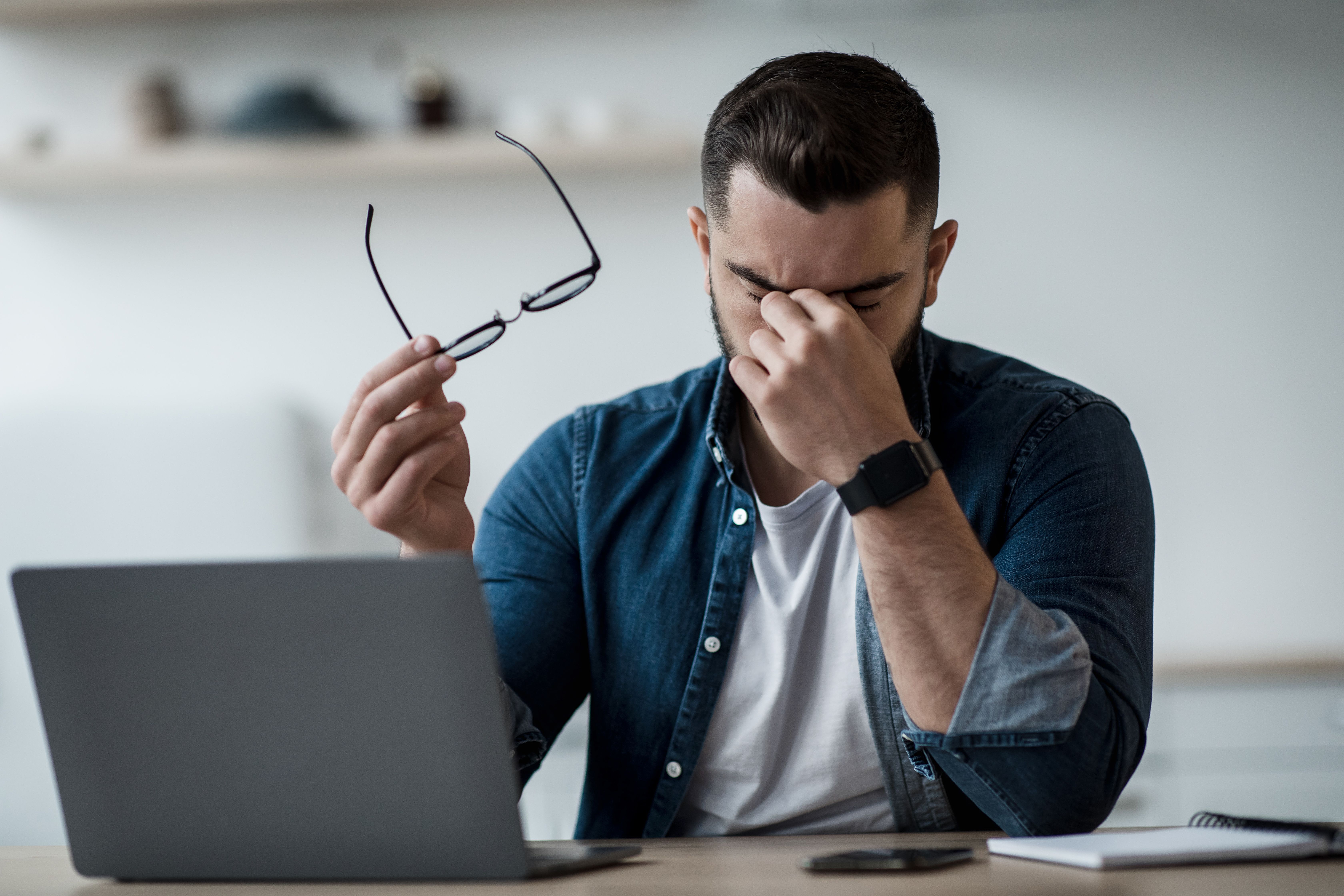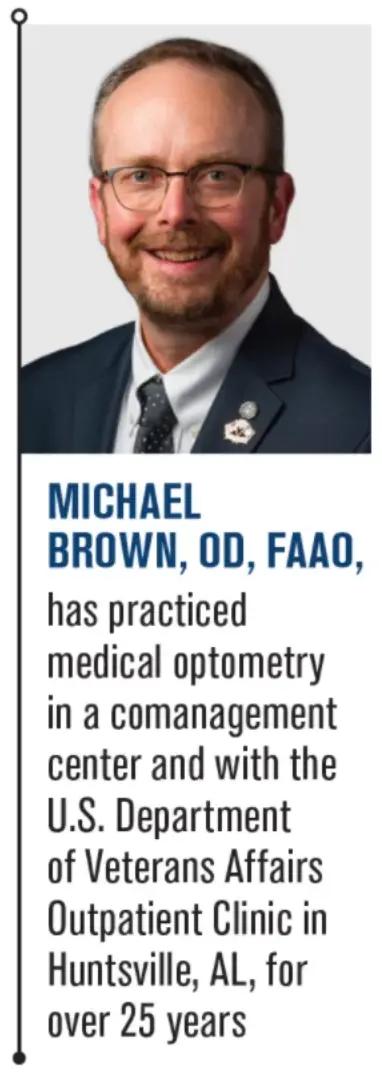The double standard of clinical care: Do as I say, not as I do
Michael Brown, OD, MHS-CL, FAAO reflects on how, sometimes, doctors fail to practice what they preach


A recent experience while examining an ocular telehealth patient was the source of an epiphany: seeing a patient on a computer screen during a live, tele-videoconferencing exam can be like staring into a mirror at your own reflection.
My patient was a 30-something professional who spent anywhere from 10-12 hours a day at a computer. She had the classic litany of complaints listed in the American Optometric Association’s (AOA) definition of computer vision syndrome: eyestrain, headaches, blurred vision, dry eyes, and neck and shoulder pain.
I launched into my usual spiel and educated her on spectacle correction options that might help, how to minimize glare, ensure proper viewer distances, angles, and seating posture, as well as blinking “fully and often” while following the “20-20-20” rule.
I finished my soliloquy, but then felt a sharp pull at my mouth, like a hard yank on a bridle bit.
Oh, yeah, I remembered: I’m a hypocrite.
Do as I say, not as I do
So, lest she think I’m some sort of Wizard of Eyes floating above the digital fray, I tore back the curtain, and in a moment of transparency and vulnerability, said, “Do as I say, not as I do.”
I then told her what I experienced both during and after an 8-hour shift of examining patients online because I often failed to “practice what I preach.”
Despite my having a sit-to-stand desk riser, an adjustable computer monitor, arm desk mount to improve viewing angles, and computer progressives (PALs) with an AR coat and blue filter, I still too often stare all googly and dry-eyed at the screen for hours while rarely taking a break, the result being similar symptoms as hers.
I held up my almost-empty bottle of artificial tears to the camera as an object lesson to bring home the point: “Even my bottle of artificial tears is dry. We’re no different: computer vision syndrome affects doctors, too.”
She remained silent but seemed locked-in on my true confession.
There, I thought, I’m finally getting through to this one! We seemed to be having a breakthrough moment that was forging a strong doctor-patient bond, one that might lead to action approaching some semblance of, dare I say, compliance.
Ergonomics
I produced and recorded a video blog (vlog) for Optometry Times recently in which I described the wear and tear I had experienced on my body while performing in-person exams for over 30 years.
See Dr. Brown’s vlog What I wish I knew before entering optometry.
I talked about the surprising physicality of practicing optometry—with all its repetitive motions like arm-raising, bending, twisting, squatting—and how it had been like water rolling off a duck’s back for many years but finally caught up with me over the last decade or so.
To make matters worse, the leading lights and so-called healthcare “geniuses and gurus,” most of whom rarely, if ever, saw patients, decided to “modernize medicine” with electronic health records (EHRs).
EHRs
While EHRs have myriad advantages over traditional paper charts, unless providers were fortunate or flush with enough cash to hire a scribe, the task of entering all that data, with its endless pointing, clicking, and keystrokes, fell upon them, along with the growing mental load of managing difficult and complex diseases and conditions.
We remained overworked and overwhelmed doctors, but we also became “glorified data entry clerks.”
After retiring from my Veterans Affairs (VA) position last year, I now spend a lot of time pulling 8-hour ocular telehealth shifts. I love the work and the professional satisfaction of being a pioneer, of sorts, helping mold and spread a new mode of practice that is improving access to quality eyecare for many patients.
Telehealth
Tele-videoconferencing ocular telehealth companies, with their high tech, team-based approach to care, have created very efficient and robust platforms that enable me to routinely examine twice as many patients as I did in a typical day at the VA.
While most of these patients are easier to manage than complex VA cases, there are still the “hot ones” who come in with undiagnosed, often silent, ocular and/or systemic diseases requiring urgent and emergent care. Just like the VA, I have frequent opportunities to make “just in time” referrals and experience the familiar thrill of helping save “sight and life.”
Ocular telehealth is a major paradigm shift for eye care practitioners (ECPs) that can rightfully be termed “progress.”
However, what I didn’t see coming was my acute case of throbbing, full-blown computer vision syndrome. I tend not to stand as much as I did at the VA when I frequently walked from my office to a lane to see a patient.
Instead, I too often remain humped over a computer screen the better part of 8 hours, and in the process, “borrow from Peter to pay Paul,” trading one set of repetitive-motion injury risks for another.
Ironically, the same motions—stretching, bending, twisting, arm-raising-- that led to my sore shoulders, aching back, and stiff neck in the first place, were now the moves I needed most whenever I did remember to take a break to stand and move around.
Perhaps a yellow sticky note stuck to the bottom of my monitor might help: “It’s about the standing and stretching, stupid.”
The truth of the matter
My patient, who had seemingly soaked in everything I had said, finally spoke up.
“Doctor Brown, I really appreciate your sharing this information with me, and I will try to do some of the things you’ve talked about it . . .”
She paused, but I knew it was only a brief intermission.
Thirty-plus years of flashbacks kicked into overdrive, and I braced myself for imminent freefall and the hard crash of disappointment. In the back of my mind, I knew my hopes of a rare, clear channel of communication and unbreakable doctor-patient bond were fleeting and too good to be true.
You see, it’s the ellipses that always get you.
“What I really want,” she continued, “is a prescription for color-enhancing contact lenses.”
The sound of falling back down to earth is not ear-splitting, but more like a soft, resigned, “Sigh.”
It figures, I thought, some things will never change. But the way I treat my body while practicing ocular telehealth had better.
There’s nothing like seeing your own reflection in a computer screen to mirror the truth back into your face and straight between the eyes.